![]()
![]()
![]()
Use LEFT and RIGHT arrow keys to navigate between flashcards;
Use UP and DOWN arrow keys to flip the card;
H to show hint;
A reads text to speech;
92 Cards in this Set
- Front
- Back
|
3 functions of the phonatory system
|
Protect the airway
Produce speech Build up abdominal pressure for support |
|
|
Structures of Laryngeal Framework 4
|
hyoid bone
9 Cartilages Connections Cavities |
|
|
Intrinsic Muscles
|
Abductor
Adductors Tensor/Relaxers |
|
|
Extrinsic Muscles
|
Laryngeal elevators
Laryngeal depressors |
|
|
Location of larynx
|
Superior to trachea, inferior to nasal/oral cavities, anterior to cervical vertebrae and esophagus
|
|
|
Hyoid bone - 3 landmarks:
|
corpus, greater horn, lesser horn
|
|
|
9 Laryngeal Cartilages
|
Thyroid, cricoid, arytenoid (2), corniculate (2), cuneiform (2), epiglottis
|
|
|
Thyroid cartilage - 3 landmarks
|
thyroid notch (laryngeal prominence)
superior horn inferior horn |
|
|
Cricoid cartilage - 2 landmarks
|
facet for thyroid cartilage
facet for arytenoid cartilage |
|
|
Arytenoid processes
|

muscular (posterior)
vocal process (anterior) |
|
|
2 Laryngeal Joints
|
cricothyroid joint
cricoarytenoid joint |
|
|
cricothyroid joint
|
allows thyroid cartilage to rock anteriorly and inferiorly
Lengthens the true vocal folds |
|
|
cricoarytenoid joint
|
allows for movement of the arytenoids
Rocking Gliding Rotating Abduction -apart Adduction - together |
|
|
Membranes that form laryngeal tube
|
quadrangular membrane
conus elasticus lined with epithelial tissue |
|
|
Supraglottic spaces
|
aditus - entryway into larynx
laryngeal vestibule - space between aditus and false vocal folds laryngeal ventricle - space between true and false vocal folds |
|
|
Glottis
|
space between true vocal folds
|
|
|
Subglottic space
|
laryngeal space below TVF (containes conus elasticus)
|
|
|
FVF
|
(ventricular/vestibular folds)
superior to true folds Can be used for screaming or for forced holding breath |
|
|
TVF
|
inferior to false
anterior attachment to the thyroid cartilage posterior attachment to the vocal processes of arytenoid cartilages |
|
|
Composition of TVF
|
Top layer = epithelial tissue – function = used for phonation (mucosal wave)
Deeper layers = muscle and ligaments – function = used for structure/support and movement of vocal folds. |
|
|
Intrinsic Laryngeal Muscles
|
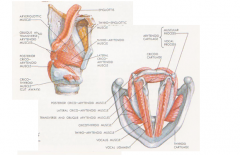
Have both origin and insertion on a laryngeal structure
Make fine adjustments to larynx Especially important for voice production 3 Adductors 1 Abductor |
|
|
transverse interarytenoid: best view
|
posterior larynx
|
|
|
transverse interarytenoid: origin
|
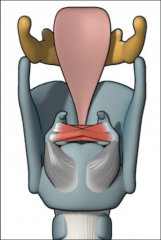
lateral surface of arytenoid cartilage
|
|
|
transverse interarytenoid: insertion
|
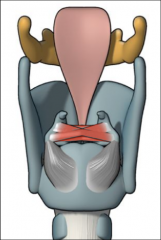
lateral surface of opposite arytenoid
|
|
|
oblique interarytenoid
oblique interarytenoid oblique interarytenoid: best view |
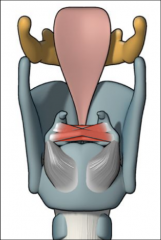
posterior larynx
|
|
|
oblique interarytenoid: origin
|
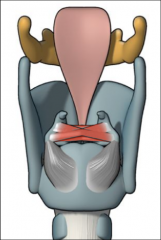
muscular process of arytenoid cartilage
|
|
|
oblique interarytenoid: insertion
|
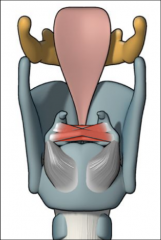
apex of opposite arytenoid cartilage
|
|
|
lateral cricoarytenoid: best view
|
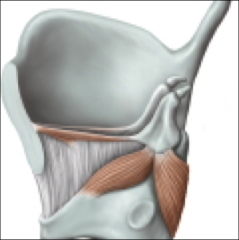
superior larynx
|
|
|
lateral cricoarytenoid: origin
|
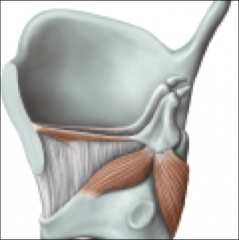
superior/
lateral surface of cricoid cartilage |
|
|
lateral cricoarytenoid: insertion
|

muscular process of arytenoid
|
|
|
Intrinsic muscles: action and innervation
|
closes (adductors) and opens (abductors) glottis
CN X (Vagus), recurrent laryngeal branch |
|
|
Intrinsic adductors:
|
transverse interarytenoid
oblique interarytenoid lateral cricoarytenoid |
|
|
Intrinsic abductor
|
posterior cricoarytenoid
|
|
|
posterior cricoarytenoid: best view
|
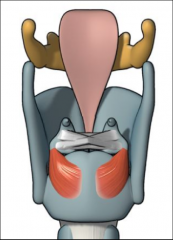
posterior larynx
|
|
|
posterior cricoarytenoid: origin
|

posterior of cricoid cartilage
|
|
|
posterior cricoarytenoid: insertion
|
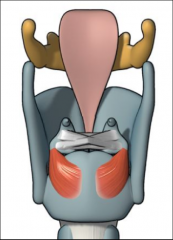
muscular process of arytenoid
|
|
|
2 vocal tensors:
|
cricothyroid and Vocalis (medial thyroarytenoid)
|
|
|
cricothyroid: best view
|
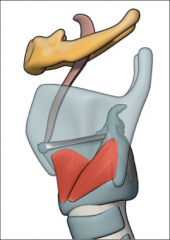
lateral larynx
|
|
|
cricothyroid: origin
|
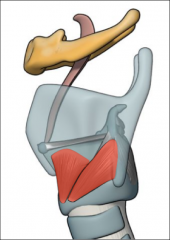
anterior surface of cricoid cartilage
|
|
|
cricothyroid: insertion
|
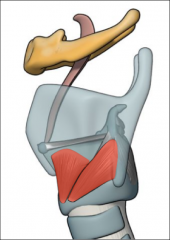
vertical part – lower surface of thyroid cartilage
oblique part – lateral surface of thyroid cartilage, by inferior horns |
|
|
cricothyroid: action
|
tense & lengthen TVF
|
|
|
cricothyroid: innervation
|
* CN X (Vagus), superior laryngeal branch
|
|
|
Vocalis (medial thyroarytenoid): best view
|
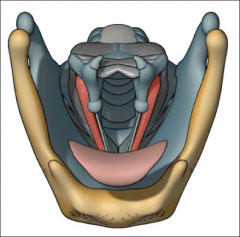
superior larynx
|
|
|
Vocalis (medial thyroarytenoid): origin
|
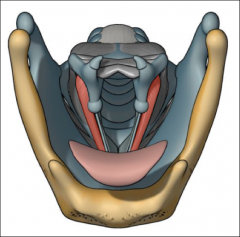
thyroid cartilage (inside, near notch)
|
|
|
Vocalis (medial thyroarytenoid): insertion
|
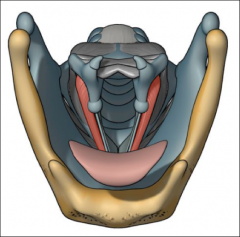
vocal process of arytenoid cartilage
|
|
|
Vocalis (medial thyroarytenoid): action
|
tenses TVF
|
|
|
Vocalis (medial thyroarytenoid): innervation
|
CN X (Vagus), recurrent laryngeal nerve
|
|
|
Vocal fold relaxer
|
lateral thyroarytenoid
(thyromuscularis) |
|
|
lateral thyroarytenoid (thyromuscularis): best view
|
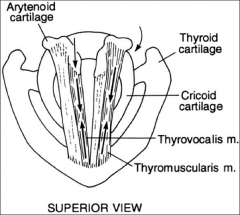
superior larynx
|
|
|
lateral thyroarytenoid (thyromuscularis): origin
|
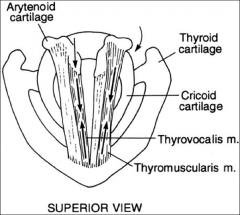
thyroid cartilage (inside, near notch)
|
|
|
lateral thyroarytenoid (thyromuscularis): insertion
|
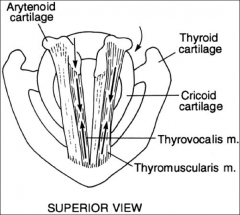
muscular process of arytenoid cartilage
|
|
|
lateral thyroarytenoid (thyromuscularis): innervation
|
CN X (Vagus), recurrent laryngeal nerve
|
|
|
lateral thyroarytenoid (thyromuscularis): action
|
relaxes TVF
|
|
|
Extrinsic muscles
|
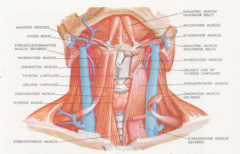
Have one attachment on a laryngeal structure and the other attachment on a distant structure
Make gross/large movements on larynx (i.e., raise or lower) Especially important for swallowing (to move larynx out of harm’s way) 4 laryngeal elevators 3 laryngeal depressors |
|
|
mylohyoid: best view
|
anterior neck
|
|
|
mylohyoid: origin
|
inner surface of mandible
|
|
|
digastric, anterior belly: best view
|
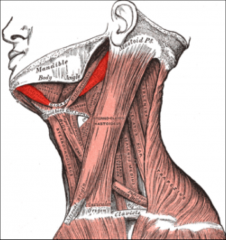
anterior neck
|
|
|
digastric, anterior belly: origin
|
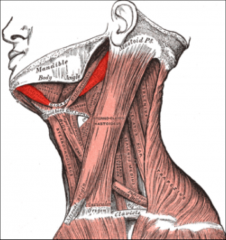
symphysis of mandible
|
|
|
digastric, anterior belly: action
|
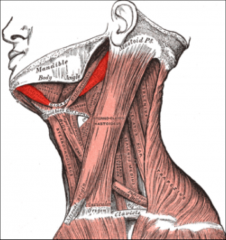
move hyoid up & forward
|
|
|
mylohyoid: action
|
move hyoid up & forward
|
|
|
digastric, posterior belly: best view
|
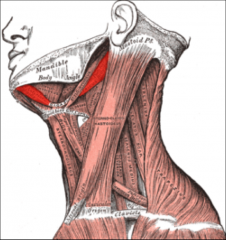
lateral neck
|
|
|
digastric, posterior belly: origin
|
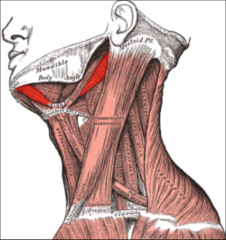
mastoid process of temporal bone
|
|
|
digastric, posterior belly: action
|
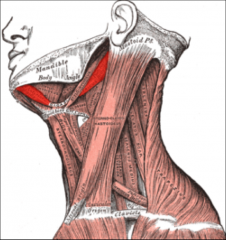
move hyoid up & back
|
|
|
stylohyoid: best view
|
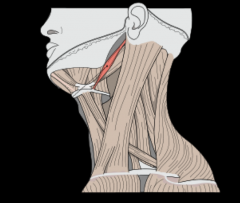
lateral neck
|
|
|
stylohyoid: origin
|
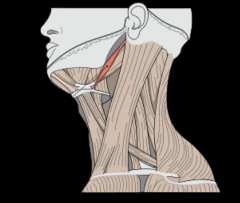
styloid process of temporal bone
(behind ear) |
|
|
stylohyoid: action
|

move hyoid up & back
|
|
|
geniohyoid: best view
|
superior mandible
(*deep to mylohyoid) |
|
|
geniohyoid: origin
|
symphysis of mandible
|
|
|
geniohyoid: action
|
move hyoid up & forward
|
|
|
Laryngeal elevators (suprahyoid)
|
mylohyoid, digastic (anterior and posterior), stylohyoid, geniohyoid
|
|
|
Laryngeal depressors (infrahyoid)
|
sternohyoid, sternothyroid, omohyoid (superior and inferior)
|
|
|
Sternohyoid: best view
|
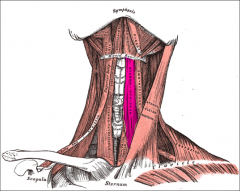
anterior neck
|
|
|
Sternohyoid: origin
|
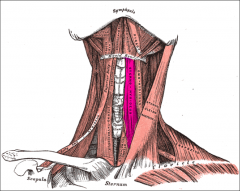
sternum
|
|
|
Sternohyoid: insertion
|
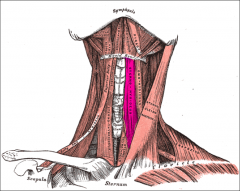
hyoid bone
|
|
|
Laryngeal elevators: insertion
|
hyoid bone
|
|
|
sternothyroid: best view
|

anterior neck
|
|
|
Sternothyroid: origin
|
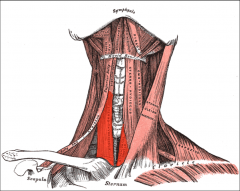
sternum
|
|
|
sternothyroid: insertion
|
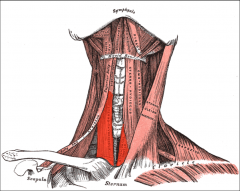
thyroid cartilage
|
|
|
omohyoid
(superior & inferior bellies) : best view |
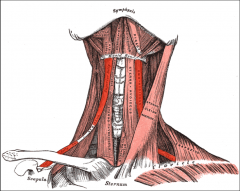
anterior neck
|
|
|
omohyoid
(superior & inferior bellies): origin |
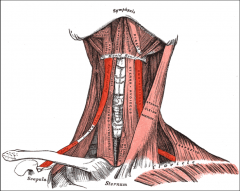
scapula
|
|
|
omohyoid
(superior & inferior bellies): insertion |

hyoid bone
|
|
|
Laryngeal depressors: action
|
move larynx down
|
|
|
Phonation:
|
“voicing”; occurs when TVF are adducted and vibrate in the upper airway.
Voiced sounds require phonation; voiceless sounds are produced without phonation. Adduction or abduction of the TVF occurs in less than 9 ms (9/1000 sec)! |
|
|
Whispering:
|
TVF are slightly adducted to create turbulence in airstream, but not so much as to achieve phonation
|
|
|
5 layers of TVF
|
3 Layers of Cover: Epithelium, superficial and intermediate layers of the lamina propria
2 Layers of Body: deep layer of lamina propria, thyroarytenoid (vocalis) muscle |
|
|
Textures of layers
|
Superficial: gelatin
Intermediate: soft rubber band Deep: cotton threads Vocalis: stiff rubber bands |
|
|
Vocal ligament
|
lamina propria
|
|
|
Subglottal air pressure necessary for phonation:
|
3-5 cm H2O, use more in conversation
|
|
|
Bernoulli Principle
|
Given a constant flow of air, at a point of constriction, there will be a decrease in air pressure perpendicular to the flow and an increase in the speed of flow. When pressure drops, this creates negative pressure (vacuum)
|
|
|
Phases of phonation
|
1. Vocal attack (begin adduction with exhalation) – 3 sub-types
breathy vocal attack (exhalation before adduction; “hyaline”) simultaneous vocal attack (“vestible”) glottal attack (adduction before exhalation; “omohyoid”) 2. Sustained phonation (maintain adduction with exhalation) Can alter pitch and loudness while sustaining phonation 3. Termination of phonation (abduction of TVF to stop vibration) Required for voiceless sounds & breathing 1 muscle of TVF abduction = |
|
|
3 Modes of Phonation
|
Glottal Fry, Modal Phonation, Falsetto
|
|
|
"Norms” for Fundamental Frequencies:
|
Adult Female: ~212 Hz (165-255 Hz)
Adult Male: ~132 Hz (85-155 Hz) Child: ~300 Hz |

